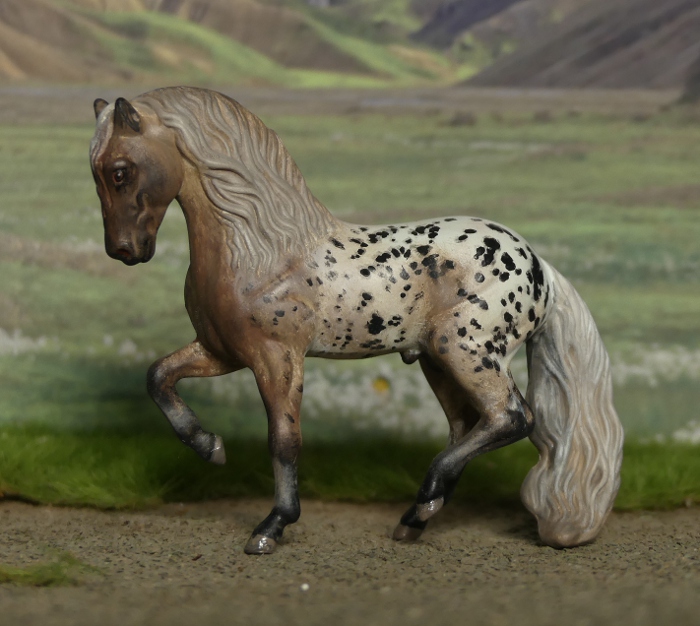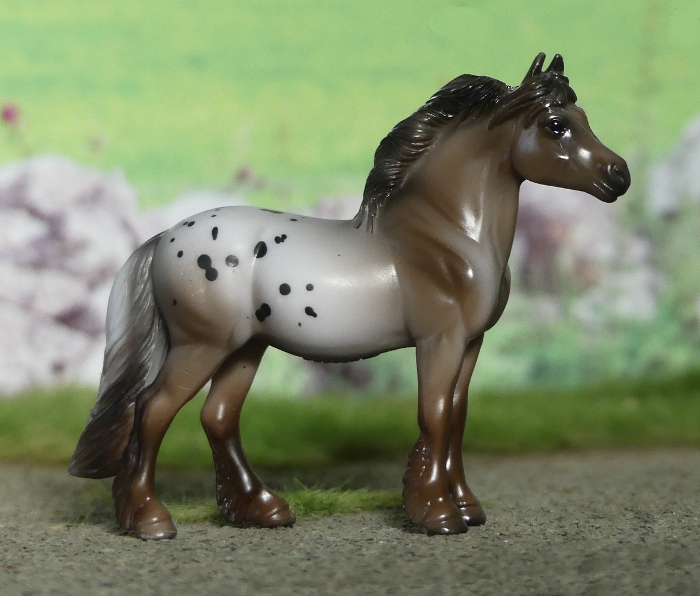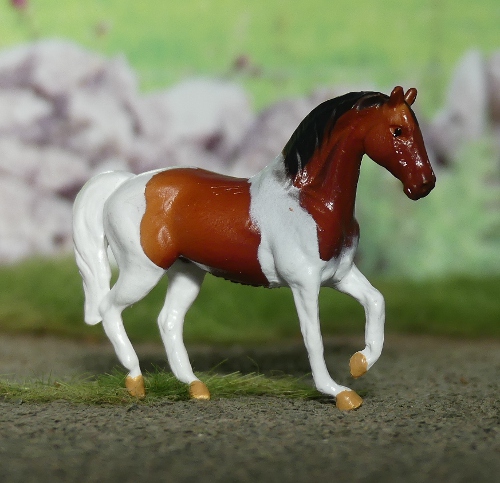I've been painting a lot of Stablemates over the last few weeks, and haven't kept up with posting them, so I thought I'd make them share one big post rather than introduce them one or two at a time like usual - my apologies for the sheer amount of photo to scroll past here!
This is Harecroft Talisman, a fell pony. The miniaturised Fell mould was released in those anniversary blind bags, as a chestnut - a colour so rare in the breed that the books don't even bother to list it as a colour they come in, and I've only managed to find a picture of one single individual online.
I can only assume Breyer are saving the typical black colour for the first regular run release on a blister-pack card, but I wanted a black Fell Pony now rather than waiting however many years it takes for that to happen, hahah!
I think mine's a little bit different than the eventual Breyer paintwork will be, though, I've given him sun-fading on the ends of his mane and tail, and a hint of brown round the face, as most of the real Fells do have this, rather than being pure jet black from nose to tail tip.


Another angle with the bright sun bringing out his highlights, and the other side, with that lovely long mane! It's a lovely little mould, which as a rare breed we probably wouldn't have got if it hadn't existed as a Traditional mould first.
This is Johnny Cash, based on a lovely big gentle gelding who used to live in the field next door to my own horse. She's very picky about who she trusts and who she either hates or is afraid of, and this boy was on her 'perfectly safe to have around' list, they weren't quite friends but she wasn't stressed out by him, which is always nice!
He was another of the blind bag Mini moulds, this time the vintage Clydesdale Stallion. I never though the build of the large mould made a very true-to-type Clyde, and the tiny one was no better, so he had a makeover to be a chunky cob instead! I gave him a new full loose mane and tail, plus thicker hairy feathering on his legs.
His small mottled markings are copied from the real one, I even found a picture I took of him having a nap so I could get the pink and black speckles in the right place on his underneath!
Now, did anyone else here read the Silver Brumby books? I loved them as a teen, cos they were about horses but not riders - the feral horse herds in the south of Australia, living and behaving as wild horses would. Not 100% accurate in terms of what we know now about horse herd hierarchy and colour genetics, but pretty close, and a huge refreshing change from all those 'girl at posh yard with epic-backstory-horse wins things' horsey novels which flood the market. I could relate more to wild horses just being horses than I could to Horse Girls, hahah!
This is a portrait of Thowra, the main character in the first book and whose family we follow through others. From the story itself, we're told he's palomino (not a grey, as some of the book covers show him - publishing company misled by the 'silver' in the title, maybe!), but that it's a very very pale shade of palomino, a bit like the famous mustang Cloud, possibly even lighter.
I see there's more books than I ever read when I was getting them from the town library, but according to reviews the later ones are not well written, and have disappointingly poor or downright depressing plots, so if I do ever buy and re-read any more (I only own the first), I'll stop at the 4th book and count that as the end, just like I did years ago when I didn't know the series had carried on!
This is my first repaint on this mould, the Endurance Arabian. I tweaked the sculpting of the cheek and nose a bit, as it had such a shallow jaw and undefined muzzle before, but the rest is unaltered.
Usually for fleabitten greys, I rely on speckles flicked on with a toothbrush, but for this one I added a layer of hand-painted hair over the top of the speckling, it takes a very steady hand to keep the tiny strokes fairly short and fine, but looked effective enough in the end to be worth it!
I'll admit something - this isn't how she originally looked when I thought I'd finished her, and stood her on the mantelpiece. Her mane was pale grey with just a hint of darker shading at the roots, and the more I looked the more I couldn't ignore how much I hated it. It wasn't awful or badly painted, it just wasn't RIGHT on her, so I got up and fetched her back, and gave her the dark mane and tail you see here. I think it was the right decision, now she looks fine even though this isn't the colour I had in mind when planning her paintwork!
He's fine for what he is, I'm not disappointed with how he actually looks, only frustrated that I keep painting the same kind of appaloosa almost every time I try a different one! I've named him Harecroft Galaxy Of Light.
Back to the blind bag horses, and the mini Smart Chic Olena mould - the same as I painted as a chestnut Quarter Horse last week, but equally good for a Paint Horse, I think.
I usually do tobiano patterns, so I decided to go overo first for a change! His markings were made up, for the simple reason that inventing them is so, so much easier than trying to copy photos onto a 3D surface, and I only put myself through that difficulty if it's a portrait of a real horse I want to create - when it's a made up one just cos I fancy owning a certain colour pinto, then the pattern can be fictional!
I'm enjoying painting these new moulds, even though I really like a lot of older Stablemates it's a refreshing change and new challenge to have different sculpts in-hand and plot what to do with them, especially as I only have one or two of each, so there's a feeling of not wanting to 'waste' them on a colour which doesn't work well!
His colour inspiration was this horse I happened to see when browsing Spanish horses for sale (definitely not to buy, I have my native ponies and don't ride any more - but sales sites are wonderful for naming and painting ideas!) I thought that was such a stand-out colour with his unusual liver chestnut base coat and appaloosa detailing, he just had to become a model for my mini herd!
I'll be filing him as a Spanish Jennet on my website, a historical breed with evidence for spotted patterns in art from the era. I don't mind a bit having extinct breeds in my collection, most of them are horses I've copied from centuries-old paintings so he'll have plenty of company.
But there is a current breeding project aiming to recreate the Spanish Jennet, by crossing Peruvian Paso and Paso Fino horses with Appaloosas, to combine the gaits, the body type, and the spotting - so it's a bit of a matter of debate whether I ought to make them a page as an existing breed, or carry on putting them on my 'historical breeds' page?! Either way, I had fun painting him!
The sun in this final shot might make his colouring stand out a bit more, he's faintly roaned outside of his blanket markings, with a couple of stray white spots, too.
This next one was an experimental horse - I remembered reading ages ago that dappled patterns can be done using pencils, and while I think they meant artists' colouring pencils, I haven't got any of those, so I thought I'd try using a normal grey writing pencil, and see what happened...
Dapples happened!
I was surprised how effective it was, in very little time the pattern started to come up pretty clearly, and with each repeat covering of scribble they got darker and better defined. I finished her off with paint for the mane and tail cos I wouldn't have been able to get the pencil into all the little grooves of the hair texture, and for the shading and markings on the limbs and face.
She's really quite pretty, a colour I wouldn't have been able to get quite the same with painting, and something I'll definitely try again, maybe in combination with more paint shading over the top to get darker, or a more rose-grey effect.
I've included this picture of her laying down, cos I think you can see the scribble work a bit more clearly like this!
Then it was back to paint...
This was a colour idea I'd had in mind for this little chunky pony mould ever since I first saw it - a pony cob.
Quite a few traditional cob breeders in the UK are aiming to make a smaller type now, about 12-13hh instead of the usual 15-16hh traditional cob type, while keeping the true chunky type and heavy feathering on the legs. Before, if you wanted a pony sized cob either for driving or children to ride, it was usually a cross with a native welsh or partbred pony, so it'd be a lot lighter in build and more pony proportions, where these look just like scaled down large cobs.
There's no real breed name for them yet, they're locally known as 'pony cobs' but could be known by different terms elsewhere, just like the big ones are a cob to me and a vanner to an American and a tinker to a German, and so on!
Pony cob doesn't have a name yet, but I really like how he turned out - as usual he's got made up markings because copying from a picture stresses me out and rarely goes right, so I only make myself do it when it's for a portrait model of a horse I know. This one's just a general example of his type, who exists purely because I wanted to do the pretty colour on the cute sculpt!
It's a much smaller mould than most Breyer Stablemates, his head only reaches the shoulder of the Arabian posted up above him there - which makes it fun to paint, and gives a bit of variety when he's standing among mostly horse-sized breeds!
This will be my last batch of customs for a little while - I'm taking time off, injured!
At work last week I tweaked something in my lower arm while pruning a too-thick branch at a very funny angle - first my index finger went into cramp and wouldn't move, then after a few minutes it was twitching all on it's own, then eventually I got control and feeling back, and was able to carry on.
But the following day it felt tingly, my arm was very strained and sore, and I'd lost all grip strength in that hand. It's gradually coming back and hurting less, day by day, but I can't hold models or paintbrushes to carry on with my repaints til it's properly healed.
But with the amount I've been getting through lately, taking a break is probably a good thing!








































